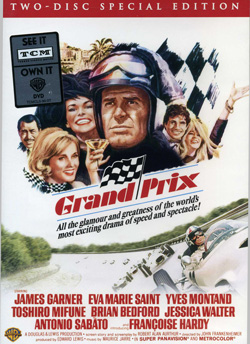|
|
|
Joyce says... Grand Prix is often cited as the best auto racing movie ever. We wouldn’t go that far. In fact, we can think of several films that we like better either for the racing or for the storyline, but as racing films in general go, this is definitely in the top ten. There are several reasons, in fact, for spending a minute or two shy of three hours parked in front of the set, not least of which is the racing. Renowned director John Frankenheimer (The Manchurian Candidate) was in a race of his own to get the film done because in spite of tremendous cooperation from Formula 1, the teams and the tracks for Grand Prix, Steve McQueen and associates were also trying to do an F1 film then. Not only did Frankenheimer win, McQueen’s F1 project never happened and it was another 5 years until he made the superior Le Mans. There are clips from several F1 tracks, some really solid camera work including the first on-board cameras in F1 history. James Garner’s wreck at Monaco into the bay was based on fact (it had happened twice in real F1 races). If you don’t feel at times like you’re behind the wheel racing, there’s something wrong with you and the sensations are further enhanced because much of F1 at the time was done on real roads. The closeness to buildings and people is incredible (and too close, as two fans in the film found out). And trees. My goodness, the trees are close to the racing surface, especially the high-banks at Monza. It should be noted (and it is in the film) that Monza hadn’t used the high-banks since 1961 but the filmmakers found the stretch irresistible. You’ll quickly see why: Monza’s high banks are like Talladega on steroids. And the thickets of trees that line the track just scream unsafe at any speed. Suffice it to say this was the best setting for the movie’s climax and Frankenheimer made the most of it. The film focuses on the top four drivers on the circuit and their love lives. And frankly, this is the weakness in the movie. They could have skipped Barini, who is charmingly played by Antonio Sabato (Senior who was famous in Europe, not Junior who is better known in the U.S.). But his storyline is the weakest of the four and adds nothing substantial. Garner as the American Pete Aron, Yves Montand as Sarti, and Brian Bedford as Stoddard turn in excellent performances. This is one of Garner’s best roles ever—his love of racing comes through so clearly. The women are fine, especially Jessica Walter as a fairly unsympathetic character, but if Frankenheimer had cut out Barini and reduced the off-track romance stuff by about a third, the film would have been only two hours instead of three. Granted, the 1960s was a time of movies with overtures and intermissions, but had Grand Prix been tightened up a bit it would have been a better film overall. Still, Grand Prix is one of the most successful racing films, finishing in the top ten grossing movies of 1966. And more than 40 years later, the racing sequences remain superb. Considering how little side-by-side action there is in a real Formula 1 race even today (or especially today), Frankenheimer’s use of on-board cameras, interesting (and, at the time, innovative) camera angles influenced every racing film that has come after. Type of Racing: Formula 1 racing Tracks: Several, including Monaco, Brands Hatch, Spa and Monza Reel Racers: James Garner, Eva Marie Saint, Yves Montand, Brian Bedford Real Racers: Many, many in cameo including Graham Hill, Jack Brabham, Juan Manuel Fangio, Dan Gurney, Phil Hill and Jimmy Clark Year of Release: 1966/2006 Re-release DVD Length: 176 minutes in new version Approx. On-Track: 62 minutes Color/B&W: Color Watch for: . . . The cars are actually Formula 3 mocked up to look like Formula 1. But there is a substantial amount of real Formula 1 race footage, too. . . . Frankenheimer refused to film the principles driving the cars slowly and then speed up the film. He believed that sharp-eyed racing fans would note the difference, so all four major actors did some of their driving (real drivers filled in other sequences). Of the four, Garner was a natural and did almost all of his own stunt driving (he went on to race for real, as well, in off-road and sports cars). Sabato was very nervous and struggled. Montand scared himself so badly that he had to be hooked up to a tow car—that took him around the track at 130 mph. Englishman Bedford couldn’t drive at all, so nearly all of his sequences were done by racing sophomore Jackie Stewart. That’s why you’ll nearly always see Bedford’s character behind the wheel with dark goggles and a balaclava. . . . Frankenheimer had trouble keeping crowds excited after several retakes of scenes. So, in one instance he had the crew literally blow up the refreshment cart at the same time the flaming race car pulls into the pits. And now you know why the crowd was really in to it. |
